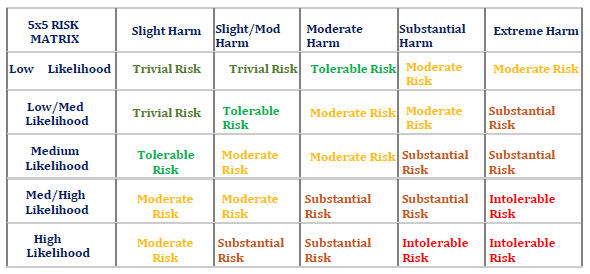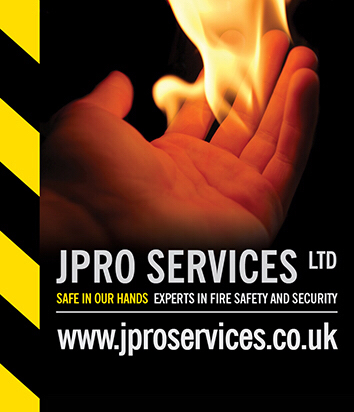Title Page
Standard Scope of services
-
Management & Competency Schemes applying to the works as detailed on the Quotation Document Ashview Consultants Ltd will carry out a Life Safety Fire Risk Assessment to meet the requirements of the relevant Fire Safety Legislation, Industry Guidance Documents and Applicable Standards. The building regulations are a statutory requirement which are controlled and enforced by the Building Control Authority at design & construction stages. As such these will be classed outside the scope of the Fire Risk Assessment. A Fire Risk Assessment should be competed for new / refurbished buildings prior to occupancy, and again when the building is fully occupied. We will complete a Non-Intrusive inspection of the site and would request that all areas are made accessible at the agreed time of inspection (including ceiling / roof voids). Some sites may have a sample of areas visually inspected (dependent on type and size of premises), which will be agreed at the time of the inspection. If areas are not accessible, they may be omitted from the report, or a secondary visit may be required which will incur an additional charge. Accurate floor plans of the Premises will be required for all assessments and must be received by our office a minimum of 48 hours prior to the agreed inspection time. If plans are not supplied in time the inspection may need to be rescheduled; or plans may be completed at the time of inspection - this will incur an additional charge. At the time of inspection, the Assessor will also discuss the Fire Safety Provisions & Maintenance with on- site staff. We would request that any Fire Strategy Reports, Design Certificates and Fire Safety Records are readily available for Inspection. If dangerous conditions or hazardous processes are noted at the time of the inspection, the Assessor will inform the site manager prior to leaving the site. (where possible). The Assessor will not intervene personally to resolve any issues. At the time of inspection, the Assessor will not complete any functional tests on equipment, complete measurements (other than distances) or take samples of articles. Private dwellings: in the case of flats, apartments, maisonettes or similar will not normally be included in the scope of the Fire Risk Assessment, except observations on the flat entrance doors and automatic detection within, where access is granted. The consideration of process related risks covered by Hazardous Substances or Explosive Atmospheres are not included. The Fire Risk Assessment Report will be prepared off site. The Report will detail the significant findings, recommendations, photographic and plan locations of points referenced. It will also provide an overall assessment of risk identified. The Assessment will be based solely on the evidence seen at the time of the inspection. As this is a subjective process, we can give no assurances that subsequent inspections undertaken by enforcing authorities will not result in a different evaluation. The Client will be responsible for the Health & Safety of the Assessor whilst on your Premises. All appropriate PPE requirements and any specific site safety rules must be relayed to our office and Assessor a minimum of 48 hrs prior to the inspection visit. Our Professional Indemnity Insurance warrants advice provided by our company at the time of the assessment, and subsequently for 12 months after completion, subject to circumstantial change. Property Protection and Business Continuity will not be included in the scope of a standard Life Safety Fire Risk Assessment. If this service is required, as requested by other interested parties, please contact our office.
-
Site conducted
-
Conducted on
-
Prepared by/Auditor Name
-
Location
Untitled Page
General Description of Premise and Occupants
-
Brief Overview of premise structure and make up/age/proposed build/levels/access and exits
-
Description of Building occupation use:
-
Main use of building:
-
Employer/Appropriate person:
-
Competent person on site:
-
Type of floor Separation:
-
Occupancy Type (Eg. Tenants)
-
Number of Floors
-
Number of floors occupied
-
Detail each level Approx. floor area (m²) covered in this inspection (e.g GF 764m², L1 842m²)
-
Approx floor area (m²) – Total
Normal Day Occupancy
-
Approx. number of staff:
-
Approx. number of others:
-
Approx. no of fire wardens:
-
Total Fire Wardens Areas:
Normal Night Occupancy
-
Approx no of staff
-
Approx no of others
-
Approx no of fire warden’s
-
Total Fire Wardens Areas
Max Day Occupancy
-
Approx no of staff
-
Approx no of others
-
Approx no of fire wardens
-
Total Fire Wardens Areas
-
Occupants At Special Risk
Max Night Occupancy
-
Approx. no of staff
-
Approx. no of others
-
Approx. no of fire wardens
-
Total Fire Wardens Areas
Occupancy - Additional Information:
-
Occupants At Special Risk (Provide any relevant information here)
-
Occupancy Notes (reference to contractors & visitors to site/office/permits etc):
-
Sleeping:
-
Please provide details:
-
Disabled:
-
Please provide details:
Emergency Evacuation details
-
Details of emergency evacuation plan:
-
Remote
-
Provide Details:
-
Isolated
-
Provide Details:
-
Young Persons
-
Provide Details:
-
Infants
-
Provide Details:
Normal Hours Of Use
-
Mon:
-
Tue:
-
Wed:
-
Thur:
-
Fri:
-
Sat:
-
Sun:
-
Hours of use:
Premise Details
-
History of Fire Incidents
-
Fire Assembly Point
-
History / Pending Enforcement/ Prohibition Action
Control Panel and Risk Summary
-
Upload and insert this section in final report
ADVICE ON CONTROL AND MAINTENANCE OF PREVENTATIVE MEASURES
-
Records should be kept of all testing, maintenance and staff training to enable the responsible person to demonstrate they have taken all responsible steps to maintain adequate fire safety standards.
Structural Fire Precautions
-
Compartmentation & Fire Stopping should be inspected following any works that may compromise fire resisting walls or barriers. If installation of pipes or cables is completed the contractor should make good and breaches in partitions with appropriate fire stopping materials.
Note: Fire Rated Pink Foam is not suitable for fire stopping around pipes or cables.
Fire doors should be regularly inspected (at least every 6 months). All fire doors should be inspected to ensure they auto close fully within their frame, intumescent & cold smoke seals are securely fixed and there are no visible signs of damage. Door latching and locking mechanisms should be checked regularly also in the maintenance routine. Control arrangements for the actuation of door locking mechanisms should also be tested periodically. Fire doors must not be wedged open.
Final exit doors similarly should be inspected periodically, particularly emergency exits which are not used regularly. They should be tested for general condition, ease of opening and egress clearance. -
Ceilings: Are the separating ceilings in an acceptable condition?
-
Ceiling Voids: Are the accessible ceiling voids in an acceptable condition?
-
Roof Void: Is the accessible roof void in an acceptable condition?
-
Lift Shaft: Is the lift shaft in an acceptable condition?
-
Vertical Services: Are the vertical services in an acceptable condition?
-
Wall and Ceiling: Are the wall and ceiling coverings of an acceptable material?
-
Partitions: Are the fire resisting partitions in an acceptable condition?
-
Internal Doors: Are the fire doors in an acceptable condition?
-
Final Exit Doors: Are the final exit doors in an acceptable condition?
-
Fire Doors regularly inspected:
-
Provide details/advice:
Means of escape
-
Note: Fire doors onto means of escapes should be self-closing or kept locked shut (Service Risers). Fire doors should only be held open by a device that is designed to release the door on activation of the alarm. The decision to fit such a device can only be taken following a risk assessment of the door location.
Corridors, egress routes and fire exits must be kept clear of all ignition sources, combustible material and obstructions at all times. -
It is considered that the premises are provided with reasonable means of escape in case of fire
-
Has adequate design of escape routes?
-
Are the travelling distances within acceptable limits?
-
Has adequate provision of exits?
-
Exits easily and immediately openable where necessary?
-
Fire exits open in direction of escape where necessary?
-
Avoidance of sliding or revolving doors as fire exits where necessary?
-
Satisfactory means for securing exits?
-
Has alternative means of escape?
-
Escape routes unobstructed?
-
Are there suitable arrangements for occupancy control and the full evacuation of the premises?
-
It is considered that the premises are provided with reasonable arrangements for means of escape for disabled people.
-
Internal Corridors: Are the internal corridors sufficient for the occupancy?
-
Internal Stairwells: Are the internal stairwells sufficient for the occupancy?
-
External Stairwells: Are the external stairwells sufficient for the occupancy?
-
Is the flat roof escape route suitable for emergency?
-
Are the inner room conditions acceptable?
-
Are the floor coverings & delineation acceptable?
-
Are the shared escape routes for all multiple occupancies acceptable?
Control of Ignition Sources
-
Control of Ignition Sources
•Fixed electrics in the premises should be periodically inspected by a competent person, normally every five years for commercial type premises.
•A policy of testing portable electrical appliances (PAT - Portable Appliance Testing) annually is recommended to protect against Fire, Shock and Burns.
•Items of personal property brought onto the premises by staff or other parties should also have been tested.
•All gas burning equipment should be subject to annual inspection by a technician who is registered on the relevant Safety Register.
•Emergency shut down valves must be appropriately installed.
•Portable heaters should be of low risk oil filled radiator type, where required. -
Electrical Equipment Ignition Sources controlled?
-
Arson: Is the arson risk controlled?
-
Compliant Smoking: Is the smoking risk controlled
-
Hot Works: Are the hot works controlled, including for external contractors?
-
Naked Flames: Is the use of Naked Flames controlled?
-
Lightning: Is the lightning risk controlled?
Control of Hazardous Materials
-
Hazardous materials should be subject to their own specific type of assessment / report, by way of a competent contractor, appropriately qualified to complete the required works.
-
Combustible Solids: Are the combustible solids controlled?
-
Flammable Liquid: Are the flammable liquids controlled?
-
Flammable Gases: Are the flammable gases controlled?
-
Pressurised Cylinders: Are the pressurised cylinders controlled?
-
Other Materials and Dusts control?
Emergency Lighting
-
Emergency Lighting is required for most premises. The level is normally determined by hours of use, complexity of egress and occupancy. The emergency lighting should be checked monthly by the occupier to ensure it functions correctly. This is normally carried out by operating a test key switch that isolates the local lighting sub-circuit for that area. It is important the emergency lighting works when the local lighting circuit fails and does not rely on the failure of the overall circuit.
The system should be serviced at least annually by suitably qualified engineers, although depending on the age of the system and the duration of the test this may be more frequent. Further advice can be gained from relevant standards. -
Is the emergency lighting in the building adequate?
-
Are the records and maintenance of emergency lighting adequate?
Fire Safety Signs and Notices
-
Note: Safety Signs and Notices
Safety Signs are required for all premises and can be categorised into 4 main types: Prohibition Signs (Red) mean you must not, do not or stop eg. No Smoking: Mandatory signs (Blue) meaning you must do or carry out the action eg. Fire Escape Keep Clear: Warning Signs (Yellow) mean risk of danger or hazard eg. Please mind the Step: Safe Condition or Information Signs (Green) meaning where to going an emergency eg. Emergency Exit route. -
Has reasonable standard of fire safety signs and notices?
-
Is the exit directional signage adequate?
-
Is the door signage adequate?
-
Is the fire safety equipment signage adequate?
-
Are the fire action notices adequate?
-
Is the general safety signage adequate?
Means of raising an alarm?
-
The Means for Raising the Alarm must be suitable for the premises, and in the majority of cases it will be a commercial grade A type system. No matter what type of system it is, the alarm should be tested weekly by the occupant. Normally a different call point will be tested each week, in rotation, using a purpose made test key. Any faults encountered should be reported to the site manager, who can authorise urgent.
-
Has reasonable manually operated electrical fire alarm system provided?
-
Has automatic fire detection provided?
-
Has remote transmission of alarm signals?
-
Is the current method for raising the alarm adequate?
-
Are the records and maintenance adequate?
Repairs (Note only)
-
If the system cannot be repaired immediately a risk assessment should be undertaken by a competent person to ensure the area can continue to be safely used. For example, if the fire alarm was non- operational in a premise with sleeping risk it should not be occupied until the system is repaired and fully operational.
The system should be serviced by a suitably qualified engineer periodically, normally quarterly or as specified by the fire alarm designer, fire risk assessor or other interested party. Further advice can be gained from relevant standards.
Manual Fire Extinguishing Appliances
-
Manual Fire Extinguishing Appliances
Note: Means for first aid firefighting must be provided for all premises. Firefighting equipment should be wall mounted on purpose made brackets at approximately 1 meter off the floor level or positioned on appropriate floor stands or cabinets. The equipment should be checked monthly to ensure it is in position, appears undamaged and has the anti-tamper tag in place. Note: Powder type fire extinguishers are not recommended for internal use and should be replaced with appropriate alternatives. The Fire Extinguishers should be serviced annually by a competent person. Further advice can be gained from relevant standards. -
Has reasonable provision of portable fire extinguishers?
-
Hose reels provided and adequate?
-
Are all fire extinguishing appliances readily accessible?
-
Are the records and maintenance adequate?
-
Is the sprinkler / suppression system adequate/compliant?
-
Is the riser unit adequate?
-
Are the private water hydrants adequate?
Smoke Control and Ventilation
-
Smoke Control, Ventilation and Extraction Systems should be maintained periodically in line with the manufacturer's instructions. Extraction Systems should also have the duct work & filters cleaned by a specialist contractor periodically dependent on usage and design.
-
Is the smoke control / extraction adequate?
-
Records and Maintenance: Is the ventilation / air conditioning controlled?
Fire and Rescue Service
-
Are the access and facilities for the fire and rescue service adequate?
-
Communication: Are there suitable arrangements to liaise with the fire and rescue?
Fire Safety Management: Procedures and Arrangements
-
Fire Safety Policy should be readily available for all premises. This should detail actions to take if a fire is discovered, if the alarm is heard, role of the fire warden, role of the fire manager, use of extinguishers and other important actions to take when evacuating the site.
Staff will also be required to complete an Evacuation Drill at least every 6 monthly, although this may be required more frequently depending on the type of site. All staff must attend at least one fire drill per year.
The Fire Logbook should be maintained and updated regularly. If a paper logbook is completed this should be maintained on site in a fireproof location or a copy of it held off site. Where an online logbook is completed maintenance reports should be uploaded to the system as an evidential record. -
Are procedures/policy in the event of fire appropriate and properly documented?
-
Are there suitable arrangements for Summoning the fire and rescue service?
-
Are the plan drawings adequate?
-
Is the emergency plan drawing adequate?
-
Have Plan drawings been displayed appropriately?
-
Is the evacuation strategy adequate?
-
Is the emergency grab pack adequate?
-
Is the fire drill routine & log book adequate?
-
Are the housekeeping arrangements adequate?
-
Are there suitable arrangements to meet provide relevant information, including that related to hazards to firefighters?
-
Are there suitable arrangements for ensuring that the premises have been evacuated?
-
Is there a suitable fire assembly point(s)?
-
Are there adequate procedures for evacuation of any disabled people who are likely to be to be present?
-
Persons nominated and trained to use fire extinguishing appliances?
-
Persons nominated and trained to assist with evacuation, including the evacuation of disabled people?
Training and Drills
-
All staff must receive Fire Safety Training at induction and periodically thereafter. This training will cover what to do in the event of discovering a fire or hearing the alarm. It is vital this training is delivered at the induction, prior to commencing work, and should be given by a competent person. Staff should then receive fire safety awareness training as a minimum periodically, normally every 2 years for most low risk sites.
Where the site is occupied by staff, some should be trained in the role of Fire Warden / Marshall and in use of Fire Fighting Equipment. The number of Fire Wardens / Marshall's required for the site will be site specific, normally with at least 1 Fire Warden / Marshall on duty while the premises are occupied.
For premises that adopt a sweep search type evacuation, the Fire Warden search area should be restricted to an area that can be searched in no more than 1 minute. Larger areas should be sub divided, allocating sufficient numbers of Fire Wardens to satisfy this recommended search time. -
Are all staff/members given adequate fire safety instruction and training?
-
Is the fire awareness training for all staff adequate?
-
Is the fire warden training for designated staff?
-
Is the fire manager trained adequately?
-
Is the evacuation training for staff adequate?
Testing and Maintenance
-
Records should be kept of all testing, maintenance and staff training to enable the responsible person to demonstrate they have taken all responsible steps to maintain adequate fire safety standards.
-
Has adequate maintenance of premises?
-
Has weekly testing and periodic servicing of fire detection and alarm system?
-
Has monthly and annual testing routines for emergency escape lighting?
-
Has annual maintenance of fire extinguishing appliances?
-
Has periodic inspection of external escape staircases and gangways?
-
Has weekly and monthly testing, six monthly inspections and annual testing of firefighting lifts?
-
Has weekly testing and periodic inspection of sprinkler installations?
-
Has routine checks of final exit doors and/or security fastenings?
-
Has annual inspection and testing of lightning protection system?
Record Keeping and Maintenance
-
Fire drills?
-
Fire training?
-
Fire alarm tests?
-
Emergency escape lighting tests?
-
Maintenance and testing of other fire protection Systems?
Document Information and Legislation
-
Fire Risk Assessment general information. This Fire Risk Assessment pro- forma should be completed by a competent person to be deemed suitable and sufficient under the current fire safety legislation. The report is designed to provide an assessment of the risk to life from fire in the named premises and to make recommendations to ensure compliance with the fire safety legislation.
The risk assessment should be reviewed by a competent person at the date
indicated on the certificate, if there is a change to the premises (structurally or use), or if a fire occurs.
All staff should be made aware of the findings of the fire risk assessment, including those identified as being at risk.
The following Legislation is in force in Ireland and the most relevant have been considered in the preparation of this Fire Risk Assessment:
This assessment addresses the requirements of the Safety, Health and Welfare at Work Act 2005 and The Fire Service Act 1981 and 2003 and identifies the measures required to comply.
The assessment covers: All areas, which to any degree are under the control of the client -
All areas accessed, which are under the control of tenants, where the landlord has to any degree of control.
The assessment does not constitute a Risk Assessment of the tenants’ areas.
Responsibility for the carrying out of such a risk assessment lies with the nominated responsible person on behalf of the tenant.
In addition to the Legislation and Guidance Documents, the relevant Irish Standards have also been considered:
eg I.S. 291:2015 Portable Fire Extinguishers, I.S. 3217:2013 +A1:2017 Emergency Lighting, I.S. 218:2013
+A1:2019 Fire Detection & Alarm Systems
RISK LEVEL ESTIMATOR 5x5 - AS DETAILED IN FIRE RISK ASSESSORS EXECUTIVE SUMMARY
-
The following risk level estimator will be used to give an overall evaluation of risk at the site in line with BS 8800.
-
Likelihood of Fire:
Low Likelihood - Negligible potential sources of ignition with appropriate fire precautions suitably maintained.
Low/Med Likelihood - Normal potential sources of ignition with appropriate fire precautions suitably maintained.
Medium Likelihood - Normal potential sources of ignition with appropriate fire precautions, not fully maintained.
Med/High Likelihood - Normal potential sources of ignition with lacking fire precautions, not fully maintained.
High Likelihood – High potential sources of ignition with lacking fire precautions or not fully maintained.
Level of Harm:
Slight Harm - Outbreak of fire unlikely to result in any serious injury.
Slight/Mod Harm - Outbreak of fire unlikely to result in serious injury or death (including room of origin).
Moderate Harm - Outbreak of fire unlikely to result in serious injury or death (other than room of origin).
Substantial Harm - Outbreak of fire could result in serious injury or death of multiple occupants.
Extreme Harm - Significant potential for serious injury or death of multiple occupants.
Resources/Control required:
Trivial - Little or no action is required.
Tolerable - No major additional controls required, although minor improvements required.
Moderate - It is essential that efforts are made to reduce the risk within the defined time period.
Substantial - Considerable resources are required to reduce the risk. Urgent action to be taken
Intolerable - The building (or area) should not be occupied until the risk is reduced. -
Likelihood of Fire (Provide details)
-
Level of Harm (Provide Details)
-
Risk Level
-
A fire is most likely to be of an electrical type. Electrical testing and maintenance should be reviewed and addressed.
The above risk summary should not be considered in isolation. All hazards and deficiencies identified in this report should be addressed in the timescales indicated in the action plan. Where two or more organisations share a building the duty holders are obligated under the legislation to co-operate and co-ordinate their firesafety measures and fire strategy.
The risk assessment should be reviewed by a competent person at the date indicated on the certificate, if there is a change to the premises (structurally or use), a change in the fire strategy/plan
Additional Information: Record all other findings/recommendations/actions below
-
Additional findings/recommendations/actions:
Completion of site visit:
-
Enter date of site visit
-
Names of those in attendance:
-
Assessor/Auditor Signature:
-
Witness Name/Signature:














